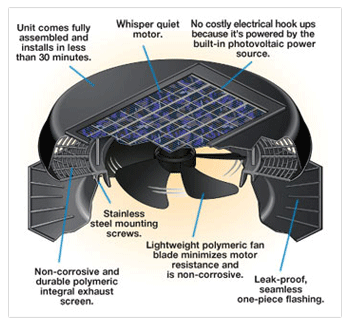Having adequate roof ventilation is a critically important part of ensuring your home stays in good shape, helping to prevent mould, mildew and insect infestation while also keeping your home comfortable and even reducing your cooling bills in the summer. Yet many homeowners are unaware of the benefits of a roof ventilation system or wrongly believe a system will wind up being more hassle than it’s worth. To set the record straight, we have a list of five of the most common misconceptions about roof ventilation systems to help you separate fact from fiction:

Solar Powered Roof Ventilation
- Roof vents are only good when it’s hot out. It’s true roof ventilation systems are important for removing excess hot air during the warm months of the year, enabling your cooling system to work more efficiently and keeping your home much more comfortable even if you don’t have air conditioning. However, in the winter, vents are also extremely important, helping to prevent moisture build-up that can cause rot and make it easier for insects to invade.
- The more roof vents you have, the better. Ventilation systems need to be installed through your roof, so obviously, the fewer holes you need to make, the better. Solatube’s Solar Star uses one small entry point to do the same amount of work as up to 15 Whirlygigs, so you don’t need to cover your roof in vents to get the maximum benefits of good airflow.
- Static vents and Whirlygigs are just as good as powered vents and fans. Actually, no. Powered vents can move significantly more air compared to non-powered options, including Whirlygigs, which means your home stays drier and more comfortable all year round. The Solar Star roof ventilation system can move the same amount of air as up to 15 Whirlygigs, and because it uses solar energy to operate, you won’t have to worry about increasing your electricity bill.
- Powered vents let out too much heat from the main part of the house in the winter. The Solar Star is designed to remove the air from your attic space, not your home. If you have heat escaping from the main portion of your home, that’s because you have inadequate insulation, and has nothing to do with the type of venting system you use.
- Roof ventilation systems are pretty much the same. If you’ve read the earlier points, you know the Solar Star is superior to Whirlygigs, moving from 10 to 15 times as much air as leading brands of Whirlygigs. In addition, the Solar Star uses solar energy, not electricity, for power, which places it far above venting systems that run up your utility bill. Plus, like every Solatube product, the Solar Star uses a special flange system to prevent leaks and ensure years of maintenance-free use, and it’s constructed of the highest quality materials for peace of mind and ease of operation. There’s also a range of Solar Star accessories
Having a Solar Star roof ventilation system installed is easy. Contact Solatube for a free quote or find a Skylight dealer in Perth by clicking here. That’s all it takes to prevent moisture damage and enjoy a more comfortable home.


We are currently building a Potting Shed and are looking for something solar to help get the air moving when it’s hot outside.
The Potting Shed is a 3m x 3m one room structure that is 2.4m high. Would a Solatube be sufficient for this?
Hi CJ,
The space you describe is relatively small compared to a typical residential roof cavity for which the Solar Stars were designed, so we see no problem achieving very good ventilation there. You may want to consider some of these factors:
– the method of mounting the Solar Star to the shed roof – this will depend on the roof profile – we recommend consulting a Solatube dealership in your area for options
– sufficient air-intakes into the shed to create free-flow of air
– depending on the model, aspect and overshadowing, potentially you’ll be looking at ~30-50 air exchanges per hour in the shed on sunny days, and even during night-time plenty of passive ventilation. For context, for a typical residential roof cavity we recommend aiming for a minimum of 5 air exchanges per hour, and for most bathrooms the standard is a minimum of 15
– on a typical roof you cannot hear the Solar Star running at all, but if the shed will have no ceiling per se, just the roof lining – the Solar Star (or rather the air rushing through it) will be audible during peak sunlight hours – something you may want to consider